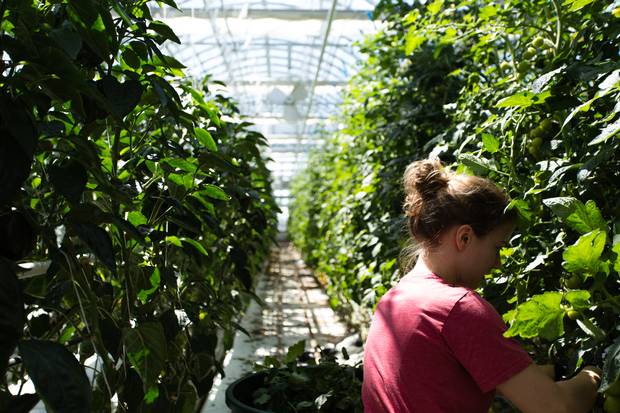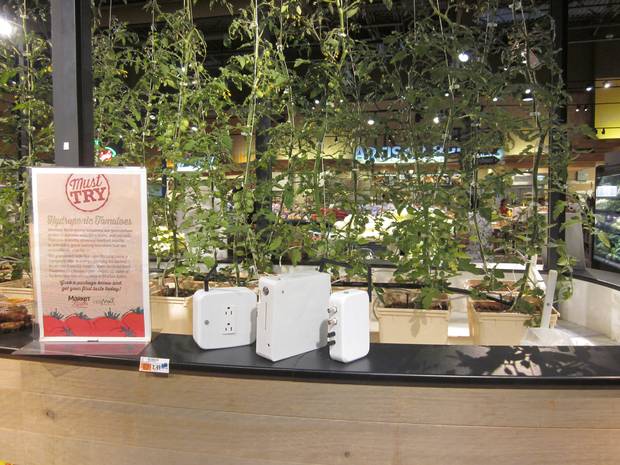Racks upon racks of spinach, arugula and kale are stacked high, washed in purple light in an otherwise dimly lit indoor facility. The plants are watered, fed and exposed to LED lights via automation, leaving people in lab coats, plastic shower caps and gloves to mill about, plucking ripe produce from hydroponic growing chambers.
It would take nearly 22 acres – almost a million square feet – of outdoor land to grow the 200,000 pounds of greens produced here at GoodLeaf Farms' 10,000-square-foot Truro, N.S., facility. And that's to say nothing of the 50,000-square-foot facility the company is planning in Southern Ontario.
Growing vertically indoors, rather than horizontally in fields, makes sense in a world marked by food insecurity, population overcrowding and an environment destabilized by climate change. The model also allows food to be brought closer to the people who consume it.
"Vertical farming is a platform to deliver healthy, clean, nutrient-rich food," says Gregg Curwin, the founder and chief executive officer of TruLeaf, the company behind the GoodLeaf Farms brand.
The problem is, it's expensive and can take a while to turn a profit. "Vertical farming is capital-intensive, so you have to be ready to scale," Mr. Curwin says.

Greg Veinott, TruLeaf’s manager of business development, inspects trays on baby kale at GoodLeaf Farms’ Truro, N.S.location, prior to sale.
TruLeaF/Suhe Du
Mark Carlson of Alberta-based agriculture-tech venture firm Verdex Capital says there's a major focus on yield improvement in the agri-tech sector. Although the American agri-tech industry raised $4.6-billion in investment last year, investors have been hesitant to sink cash into indoor farming. Evidence that widespread demand for locally grown produce can be created, met and then replicated across many markets has been hard to come by, stoking fears that funding indoor farming won't be a good return on investment.
Montreal-based Lufa Farms, which currently operates two commercial rooftop greenhouses and sells locally produced food direct to consumers via its online grocery store, is a rare example of success.
It cost the company about $3-million to build its, and the world's, first commercial rooftop greenhouse. Since it opened in 2011, they've brought the setup cost down about 30 per cent, says co-founder and greenhouse director Lauren Rathmell. She also notes that the company – which currently prepares and ships 7,000 grocery baskets a week to the Montreal area – recently achieved stable profitability.

Montreal-based Lufa Farms’ commercial rooftop greenhouse in Laval, Que.
Lufa Farms

Staff at Lufa’s greenhouse Ahuntsic greenhouse, in the Ahuntsic-Cartierville neighbourhood of
Montreal
Lufa Farms
Ms. Rathmell says Lufa depends on automation to run its two greenhouses. Water, nutrients, temperature and other factors are managed by their customized automation tool made by British Columbia's Argus Control Systems. Microgreens and baby greens grow on six-storey racks outfitted with automated LED lights, and energy curtains are programmed to roll down the sides of the greenhouses at night. "They help reduce heat loss at night by up to 70 per cent," Ms. Rathmell notes.
Smart automation can also help drive down the cost of labour. Motorleaf is a Montreal-based startup that makes hardware and software to automate and monitor indoor growing scenarios, up to five acres. "When we A/B tested a crop with Motorleaf and a crop without Motorleaf, we saved 70 per cent of our time by automating," CEO Alastair Monk says.

In July, Motorleaf debuted its in-store tomato case system in an upstate New York Price Chopper. The case is managed by Vermont Hydroponic Produce, which has since partnered with Motorleaf on a number of produce cases in New England schools.
Motorleaf
Motorleaf co-founders Ramen Dutta and Alastair Monk have developed technology which allows growers to operate greenhouses remotely.
Motorleaf/Carl Atiyeh
Mr. Monk co-founded the company with Ramen Dutta last year in Quebec's fertile Eastern Townships. Motorleaf's system equips existing pieces of indoor farming equipment with sensors and connected devices to create a wireless network. Lighting, pH, nutrient and water levels, air and water temperature, and humidity can then be remotely monitored and controlled via desktop and smartphone apps. A machine-learning component receives information from the plants and makes adjustments to optimize growing conditions.
Motorleaf's starting price comes in at $500 (U.S.), while Mr. Monk says fully equipping a five-acre greenhouse at current pricing would run between $5,000 and $10,000, making it one of the more affordable options on the market.
A system like Motorleaf's also gives greenhouse operators the gift of distance. A city dweller could theoretically operate a greenhouse 100 kilometres away, just as a farmer could go on vacation while still keeping a watchful eye on his or her crops. But Mr. Monk cautions that no single automated agricultural operation – whether it's on a rooftop in the heart of a city, or a family farm in the countryside – can thrive without one essential component: A farmer, if only to harvest the plants.